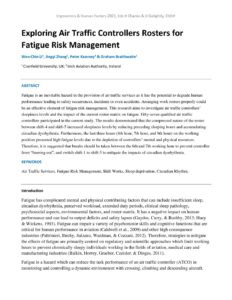| Document | Author Wen-Chin Li, Jingyi Zhang, Peter Kearney & Graham Braithwaite |
| Abstract Fatigue is an inevitable hazard in the provision of air traffic services as it has the potential to degrade human performance leading to safety occurrences, incidents or even accidents. Arranging work rosters properly could be an effective element of fatigue risk management. This research aims to investigate air traffic controllers’ sleepiness levels and the impact of the current roster matrix on fatigue. Fifty-seven qualified air traffic controllers participated in the current study. The results demonstrated that the compressed nature of the roster between shift-4 and shift-5 increased sleepiness levels by reducing preceding sleeping hours and accumulating circadian dysrhythmia. Furthermore, the last three hours (6th hour, 7th hour, and 8th hour) on the working position presented high fatigue levels due to the depletion of controllers’ mental and physical resources. Therefore, it is suggested that breaks should be taken between the 6th and 7th working hour to prevent controller from “burning out”, and switch shift-1 to shift-5 to mitigate the impacts of circadian dysrhythmia. |

